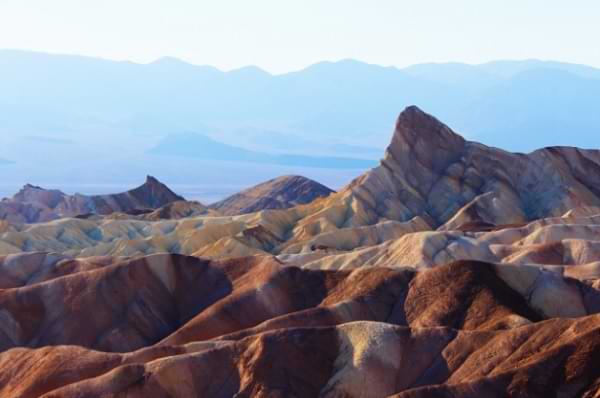
Death Valley is a desert valley in Eastern California with towering peaks that are covered with snow in the winter. This scenery makes it a prime location for photography, but are you allowed to fly your drone here? Here’s what I discovered!
You can’t fly a drone in Death Valley as it’s a National Park, and the United States National Park Service (NPS) has banned the take-off and landing of all recreational drones within national parks across the U.S. However, this law does not apply to emergency services, government officials, and drone pilots that have received special permits.
Although most national parks have banned the use of drones within their limits, the good news is that there are ways to get around this ban, so keep reading to find out exactly how you can do this!
Can You Fly a Drone Over Death Valley National Park?
Since you cannot fly a drone in Death Valley itself, you may be wondering if you can fly your drone over it, and can you do this legally?
Since Death Valley is a National Park, the law states that drones can’t take off or land in a national park. But the rule only states that hobbyists cannot take off and land their drones from within the National Park.
So does this mean that you can still fly over the park?
Yes, technically you can fly over National Park areas like Death Valley, as long as you’re not operating from within the park. The NPS has also said this is allowed in this article from their website. As long as you can find a suitable area to take off and land outside of the national park, then you should be fine to capture amazing content.
This method allows you to avoid the rules but still be obeying the rules and regulations.
Will a DJI Drone Take Off in Death Valley?
DJI will not stop your drone from taking off in Death Valley itself because the area is not a restricted fly zone. That said, it’s still illegal to take off or land your drone in death valley so just because you can, it doesn’t mean you should.
What will happen, is that the drone will prompt you and ask for confirmation that you know you are in an enhanced warning zone. The application will only ask if you are aware, and all you have to do is tick it off.
You shouldn’t have any problems flying over Death Valley as long as you are operating from outside the park.
Which National Parks Do Allow Drones To Take Off/Land?
Flying within a National Park is almost impossible thanks to the ban on drones that were issued by the NPS. However, it is still possible for, drone pilots to get “special use permits” to allow them to fly for emergency uses like search and rescue, research, and fire safety.
Unfortunately, many pilots have tried to get their hands on this permit; however, it seems almost impossible to get these permits. The NPS does not seem to hand them out easily, there’s actually only a few cases of this permit actually being issued out to pilots.
However, I have heard of people getting permission to fly their personal drones in the park. If you want to fly a drone in Death Valley, I suggest speaking to or calling the superintendent at the park and asking them.
National Parks Using Drones
Because of this permit, national parks themselves are able to use drones on their property. After all, the NPS needs to use drones as well for many reasons. They need drones for:
- Surveillance
- Search and Rescue
National Parks like the Grand Canyon actually have drone fleets used for search and rescue operations in and around the park. The fleet conducts various search and rescue operations and has made headlines in the last couple of years.
Regardless of whether you fly with a permit or you are flying from outside of the park, you need to be aware of the FAA drone rules and regulations.
What Are The FAA Drone Laws?
It doesn’t matter if you are flying commercially or for recreational use, you still need to know the different FAA rules and regulations. They are as follows:
Recreational Flyer/Hobbyist Rules
- When flying your drone, always fly below 400 feet.
- The drone must weigh less than 55 lbs.
- You must register your drone if it weighs more than 0.55 lbs.
- You must fly in class G airspace.
- Your drone must remain within visual line-of-sight.
- You must only fly for recreational purposes.
- You must follow community-based safety guidelines.
- You must never fly near other aircraft.
- Never fly near emergency response efforts.
- You cannot fly a drone directly over people.
- You cannot fly directly over moving vehicles.
Rules For Flying Commercially
- You must fly below 400 feet at all times.
- Pilots are required to fly in Class G airspace.
- Must have a Remote Pilot Certificate issued by the FAA.
- Your drone must weigh less than 55lbs.
- Must keep the drone within visual line-of-sight of the pilot or a helper.
- You cannot exceed a speed of 100mph.
- You cannot fly directly over people.
- You cannot fly over a moving vehicle.
Rules to Follow When Flying Over a National Park
Apart from the original FAA drone laws, there are a few other rules you need to make sure you follow to avoid trouble from the NPS.
- Don’t interfere with the wildlife in the park.
- Remain in line of sight of your drone at all times.
- Don’t become a nuisance to park visitors, or risk anyone’s safety.
Why Are Drones Banned In National Parks?
Drones may be fun to fly as well as being great technology for photographers and videographers to capture aerial shots, however, even though they are great, drones can be disturbing to both the people visiting a National Park and the park’s wildlife.
The ban on drones was first initiated back in 2014 after multiple drone incidents forced the NPS to ban them in various national parks around the United States.
One of the main reasons why the NPS decided to ban drones in National Parks was that they were worried drones would be a negative experience for all the people trying to enjoy the park’s beauty. Drones can be noisy and visually distracting for the people who are in the surrounding area.
Drone pilots have tried to combat the ban by stating that they could simply stay away from heavily populated areas of the park. However, drones don’t just have a negative impact on the peace of people at the park, but also on the peace of the park’s natural inhabitants, the animals.
Over the past couple of years, drones have become increasingly more popular than they were back in 2014, so you can just imagine how much worse it would be if drones weren’t banned back then!
Drone Incidents at National Parks
Even though most drone pilots are very careful and follow the rules and regulations very closely, there have been a few incidents involving drones that are closely related to the reason the NPS has had concerns over drones.
These are just some of the incidents:
- In August of 2014, when the ban was already in place, a Dutch tourist crashed a drone into the Grand Prismatic Spring geyser at Yellowstone National Park. He received a 1-year ban and was also fined $3,200.
- In 2013 a drone pilot landed his drone on Lincolns head at Mount Rushmore, causing Park Rangers to take action.
- A Helicopter used by the Yellowstone National Park was forced to land shortly after taking off, as Park Rangers were afraid it could be involved in a collision with a rogue drone flying in the park.
Related Questions
What happens if you get caught flying a drone in a national park?
So as to fly your drone in a national park, you will require a Special Use Permit. Furthermore, in the event that you are found flying without your license, National Park administration officers have the right to seize your drone. Also, the greatest punishment can be as serious as a half year in prison and a $5,000 fine!
